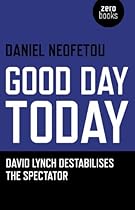

In his speech following the 2011nationwide riots in Britain; Prime Minister David Cameron spoke out against people ldquo;being too unwilling for too long to talk about what is right and what is wrongrdquo; and proclaimed ldquo;this relativism ndash; itrsquo;s not going to cut it anymorerdquo;. He was; then; presumably laying the foundation for one-size-fits-all absolutist authoritarianism and; worryingly; the moral outrage induced by the riots means a large proportion of the British public might not oppose such measures.When such a mindset is on the verge of becoming pandemic; where do we turn? This book suggests that the work of another David; born 20 years before and 3;000 miles away from Cameron; might engender a mode of thinking which does not apprehend the world in terms of such easy distinctions. In David Lynch; we find a director whose films ndash; by utilising the tropes of the Hollywood movie; but subverting their accepted meanings - profoundly destablise spectators; and lead them to consider things not in terms of prescribed binaries; but as complex and multi-faceted.
#2515592 in eBooks 2012-12-07 2012-12-07File Name: B00ABDHWXE
Review
7 of 7 people found the following review helpful. great reference guide on film musicBy picture goerFor one who collects; listens and enjoys film music; this tome is the best available in the market. It is a wonderfully comprehensive reference guide to the best film scores from the early twenties up to almost the nineties. Eminent composers are given adequate biographies. The salient highlights of the scores are reviewed by decade. The golden age of hollywood is represented by Korngold; Steiner; Tiomkin; Newman; Waxman. One can actually feel the development of film music techniques from the silents to the talkies and the sophistication of today`s electronic scores. The rise; decline and revival of this art form is well documented and one can compare different periods in terms of orchestration; styles; audience tastes and composer standards. The composer; arranger; conductor; songwriter were sometimes one person for example; Alfred Newman. The death of the studio system also spelt the end of the road for studio orchestras which employed hundreds of emigrants from Europe. Also; the predominance of Jewish composers and musicians is keenly felt even today. A good investment for any film music lover; it will pay dividends many times over. High readable and highly recommended.4 of 5 people found the following review helpful. What an attractive book!By the old guitaristTHE INVISIBLE ART OF FILM MUSIC may be the easiest to enjoy of all books on the subject. Its an inviting chronological survey of scores and trends. Year by year summaries are combined to form eight chapters; each one opening with an overview and covering a single decade: Chapter One is the 1920s; Chapter Two the 30s and so on through Chapter Eight which is 1990-97. So; pick a decade or go straight to a specific year. For example; this is what MacDonald has for these five years:1938 - a mention of Dmitri Shostakovich; a feature on Prokofievs ALEXANDER NEVSKY; then Steiners JEZEBEL; Korngolds THE ADVENTURES OF ROBIN HOOD; Honeggers PYGMALION and Kosmas GRAND ILLUSION.1945 - a long feature on Miklos Rozsa and the theremin which covers SPELLBOUND and THE LOST WEEKEND; then Herrmanns HANGOVER SQUARE; Stothart and Castelnuovo-Tedescos THE PICTURE OF DORIAN GRAY; Chopin as arranged by Rozsa for A SONG TO REMEMBER and Gershwin as arranged by Steiner and Heindorf for RHAPSODY IN BLUE.1960 - a long feature on Elmer Bernsteins THE MAGNIFICENT SEVEN; then "Historical Epics" (Tiomkins THE ALAMO and Norths SPARTACUS); Previns ELMER GANTRY; Golds EXODUS; Deutschs THE APARTMENT; Herrmanns PSYCHO and Hadjidakiss NEVER ON SUNDAY.1975 - a feature on David Shire for FAREWELL MY LOVELY and THE HINDENBURG; then Williamss JAWS; Nitzsches ONE FLEW OVER THE CUCKOOS NEST; Goldsmiths THE WIND AND THE LION; Norths BITE THE BULLET and Rosenmans BARRY LYNDON.1992 - a feature on Jerry Goldsmith for BASIC INSTINCT; MEDICINE MAN and FOREVER YOUNG; followed by Jones and Edelmans LAST OF THE MOHICANS and short mentions of Menkens ALADDIN; Ishams A RIVER RUNS THROUGH IT; Robbinss HOWARDS END; Zimmers THE POWER OF ONE and "Women in Film Music" (Rachel Portmans USED PEOPLE; Anne Dudleys THE CRYING GAME and Shirley Walkers MEMOIRS OF AN INVISIBLE MAN).Mr. MacDonald has closed the book with a 13-page; 570-film "Filmography" of the titles mentioned in the book. Under each title; we get the films year; director; composer and studio. Also; info on recordings of the score and video for the film.0 of 7 people found the following review helpful. Not wanting for effort but flawedBy TishTashAmbitious attempt at film music history; but many mistakes: The Waltons was on CBS; not NBC; the three-note motif after the introduction in Star Wars is the Rebel Fanfare; not the Empires (which before its fleshed-out motif in Empire Strikes Back was a separate six-note leitmotif); the peppy new theme in Return of the Jedi was for the Ewoks; not the Jawas.